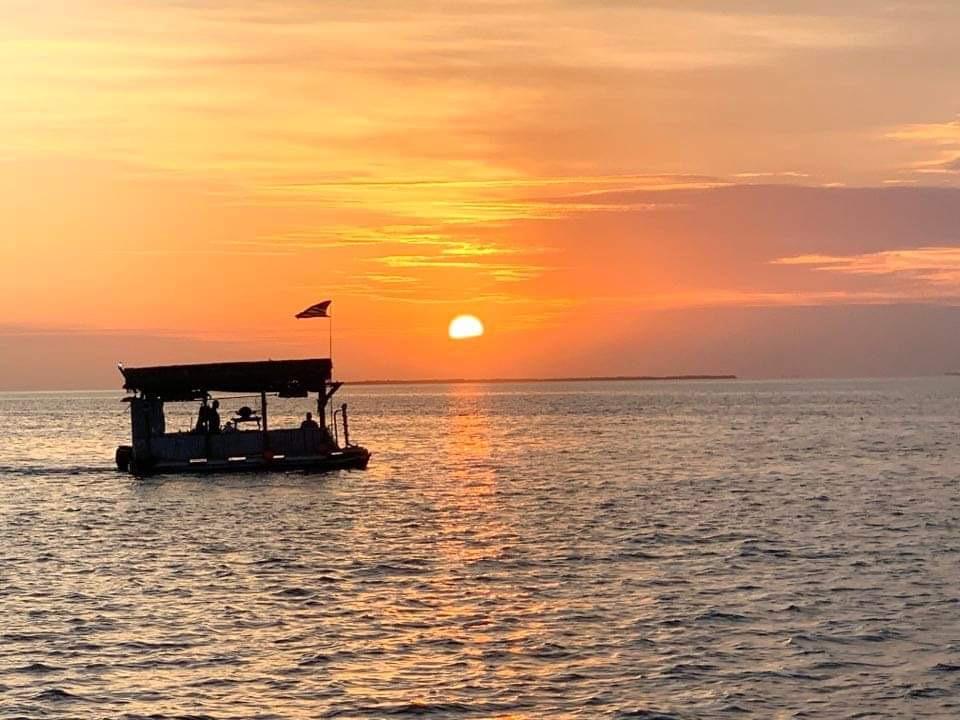
I have not written anything in over a week. My idea about coming to the Keys was to experience the people and places, and to let my creative juices flow. These days, I am finding myself observing those with the Keys Disease, and myself toying on the edge of it — the Keys Disease describes people on a permanent vacation of body, mind, and soul – often accompanied by a joyful use of alcohol. One perfect day blends into the next, with sunshine beating down on the red tips of our noses, a warm breeze blowing through our salt-sticky hair, and gentle water waves in all permutations of turquoise washing through our toes. Like the Groundhog Day, unless there is a hurricane in the forecast. We wake up in the Keys to more of the same each and every day of the year, and as time passes, we develop the Keys Disease.
The Keys Disease just as any other doesn’t discriminate and can infect any segment of the local population. I’ve met many strikingly interesting people and few are immune to the Keys Disease.
There are the Conchs — I am using the term loosely and applying it to all residents of the Lower Keys. Conchs were born in the Keys or by my definition have lived and worked here for numerous decades. Their skin reflects many years of sun exposure, going back to when sunblock was not understood and therefore the product was not applied (smother me in baby-oil, baby!). I see many of these people working service jobs and mostly socializing with their own kind. Once in a while a new person enters this crowd, but that is only permitted with an introduction and sponsorship by someone in the Conch population.
The next group are the retirees. These people tend to be snowbirds, who come here for the winter season and in the late spring, go back to New Jersey or where ever they came from. During their productive years, snowbirds accumulated enough wealth affording them two middle class households. Their house in the Keys is usually on a canal where a decent fishing boat is waiting for an opportunity to go fishing or sunning on the local sandbar.
There are also youngsters, who by my definition are pre-retirement forty or fifty-something arrivals. This group either rents or purchases less expensive housing. They might be stable, but certainly not ready to extend themselves financially. Just like the Conchs, most work in the service industry and many maintain strong social and often financial ties to their place of origin. From the stories that I hear, they escaped something on the mainland that made them unhappy. The islands, at least on the surface, lure them in, offering a promise of happiness.
Yesterday, I met an anomaly, a man who appears to be a cross between a snowbird and a younger escapist. In his mid-thirties and sporting tattoos on his face, a dagger on one side and a hand grenade on the other, this man was sitting at a local bar. My first thought was that the man was an ex-prisoner. As most people with roots in Eastern Europe, I associate face tattoos with time in prison. Yesterday was a cool evening for the Keys, so the man wore long blue jeans and a red hooded sweatshirt. One of my local friends was also at the bar and she introduced me to the grenade-faced man — I was surprised and apprehensive to make his acquaintance. In the conversation, the man revealed that he was a professional gambler. I inquired if he played Texas Hold’em, as it is a gambling game that I am familiar with due to its large professional following on the Internet and the TV. He said that he gambles on sports, all sorts of sports: football, baseball, horses, tennis – everything. He added that he is a bookie who makes money no matter if a bet is won or lost. The man then proceeded to show me a picture of a bed covered in what appeared to be one-hundred-dollar bills. His other show-and-tell was a fancy switchblade knife attached to his belt, “for personal protection,” as he boisterously stated.
I looked around the bar and thought that there must exist another group of locals who work in professional jobs such as medicine, law enforcement, or education, those who facilitate higher functions in this vibrant Keys community. I reasoned that the professionals are less often seen in the local watering holes because their life responsibilities dictate a different, more conservative lifestyle – they might be immune to the Keys Disease.
If the Keys Disease can be diagnosed by a joyful alcohol indulgence, the economy of the Keys is well architected to facilitate the ample supply — Highway 1 is lined with establishments ready to serve both the tourists and the locals. Social structure and culture of the Keys encourages the vacation-like lifestyle of going out into the beautiful sun and enjoying the myriad of available activities including boating, fishing, beaching, or hanging out on sandbars — with drinking being the common denominator.
In Florida, as long as the business has a liquor license and a separate entrance, most well-known retail-brands are in the business of selling alcohol. Next door to Win Dixie grocery is the Win Dixie Wine & Spirits store; next door to Walgreens pharmacy is the Walgreens Liquor store; Publix has Publix Liquors; there are Walmart Liquor stores, and Target Wine & Spirits.
While the professionals may have acquired immunity to the Keys Disease; the next group with a reasonable level of resistance are the snowbird retirees, who while enjoying the everlasting vacation-attitude handle alcohol very well. Their retirement is a continuous vacation of body, mind, and soul, and after many years of successful productivity, they certainly deserve to relax and enjoy their golden years.
The highest at-risk people are the newest, youngest transplants – they don’t have family responsibilities, their jobs require presence but not a high mental engagement, and their only responsibility in the world is themselves. With the social circle of like-minded individuals, in the same age-group, status, responsibilities, and life expectations, these people work hard and play hard. I heard a story describing the progression for one young new-comer who first spend his days at a high-end beach-bar then moved to a land-locked lower cost locale and finally ended up at the lowest of the low, a cheap-smelly bar behind the local 24-hour liquor store — such is the path of those who play and lose at the game of the Keys Disease.
But what about the famous local personalities? Ernest Hemingway was a transplant to the Keys — he was an icon in Key West for about a decade where he continued his literary work, established himself as a fisherman, and developed a circle of friends nicknamed the Mob. For most of his life Hemingway was a heavy drinker and while he too toyed with the Keys Disease, Hemingway managed to retain his productive routine and consistently produced a wealth of literary works. While in Key West, Hemingway wrote A Farewell to Arms (a little over 300 pages), Death in the Afternoon (almost 500 pages), To Have and Have Not (about 300 pages), and numerous short stories. Hemingway began writing at about six in the morning and continued until noon or sometimes later – morning hours of productivity resulted in about 300 to 700 words per day. Hemingway kept a daily count of words on a cardboard chart on his wall. In the afternoon, Hemingway would go fishing, and in the evening, explored Key West, often ending up at the Sloppy Joe’s bar, instigating boxing fights. A writing advice from Hemingway instructs to stop writing when you know what happens next, this way a writer will never get stuck in a progression of a novel.
As an aspiring writer, similarly to Hemingway, I am inspired by each corral rock and mangrove scattered around the Keys. The colorful people that I meet have the potential to become characters in a novel or a travelogue. The spectrum is wide, from the successful and proper humans to the disadvantaged and broken beings. I cannot compare myself to Hemingway in skill, success, or imagination. He assumed his place in literary history by dedicating many years to the craft. One thing is for sure, Hemingway’s daily dedication is what I currently lack and must develop. – I need to commit to writing daily, in meaningful and consistent blocks of time. For now, I am failing with the dedication to the cause — I tend to spend my days hanging out with friends, scheduling fun activities, and participating in the local entertainment. I might be suffering from the Keys Disease.

Special Thanks goes to Bella, who edited this piece.



I’m adding a new life goal: acquire the Keys Disease! Cheers Irena : )
I was there for less than a week and could feel the Keys Disease starting to infect me. I barely made it out! Great memories!